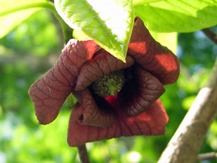ABSTRACTIn this study, students investigate whether and how much the native understory shrub pawpaw (Asimina triloba) may affect tree regeneration in a forested habitat. During one lab period in the field, they collect data on the densities of tree seedlings and saplings under varying densities of pawpaws. During a second lab period in a classroom, they test whether tree densities are lower under pawpaws, and whether plots with higher densities of pawpaws have lower densities of trees. Students then report their findings in a brief lab report. This project introduces students to key components of ecological research including transect and plot sampling, paired designs, statistical analysis and scientific writing.
AUTHORSKathryn M. Flinn Franklin & Marshall College, Biology Department, PO Box 3003, Lancaster, PA 17604, kathryn.flinn@gmail.com CLASS TIMETwo 3–4-hour lab periods. OUTSIDE OF CLASS TIMEStudents enter data and write a lab report. STUDENT PRODUCTSA brief (2-3 page) lab report—i.e., a miniature scientific paper without references. SETTINGIn the first lab period, students collect data in the field at a forested site where a focal species (e.g., pawpaw) has the potential to affect tree regeneration. This works best during the growing season. In the second lab period, in a classroom where students can bring or use computers, they analyze data and prepare to write a lab report. COURSE CONTEXTThis activity is designed for use near the beginning of a general ecology course, in an introductory course covering ecology, or in a field ecology or natural history course that may be open to nonmajors. It is intended for students with little to no background in ecology, statistics or scientific writing. Class size should be conducive to field work (10–25). INSTITUTIONPrivate, small liberal arts college. TRANSFERABILITYThis activity could be used at any institution with lab sections small enough for field work (10–25). It is suitable for biology majors in early stages of their college careers, nonmajors, and high school students. For more advanced courses, complexity could be increased. This lab could easily be adapted to any landscape with forests where an understory species— any native or invasive tree, shrub or herb—has the potential to affect tree regeneration. The native understory shrub pawpaw is common in moist forests across much of central eastern North America (range map: Flora of North America 2014). DOWNLOADSDescription of other Resource Files:
ACKNOWLEDGMENTSThis activity was inspired by Baumer and Runkle (2010). The ecological question is similar in principle to Murray and Winnett-Murray’s (2004) TIEE activity. I would like to thank Peter Marks for his mentorship of my teaching and, in particular, his influence on the teaching of writing in this activity. CITATIONKathryn M. Flinn. 17 September 2014, posting date. How do pawpaws affect tree regeneration? Teaching Issues and Experiments in Ecology, Vol. 10: Experiment #1 [online]. http://tiee.esa.org/vol/v10/experiments/flinn/abstract.html |

Pawpaw (Asimina triloba) flowers in May. Flowers are perfect—with both male and female parts— and protogynous—first female, then male. Photo by Kathryn M. Flinn. full size image |
<top> | |